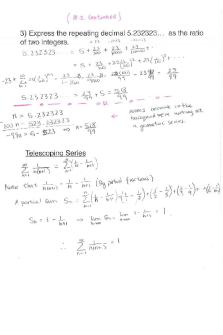Chapter 12-13 - Lecture notes 12-13 PDF

| Title | Chapter 12-13 - Lecture notes 12-13 |
|---|---|
| Course | Introductory General Chemistry |
| Institution | California State University Fullerton |
| Pages | 6 |
| File Size | 329.7 KB |
| File Type | |
| Total Downloads | 90 |
| Total Views | 189 |
Summary
Functional groups, alcohol, and carbohydrates...
Description
12.1 Functional Groups a. Alcohol - contains a hydroxyl group (–OH) i. IUPAC Naming: carbon atom bearing the OH group is designated C1, but the 1 is not used in the name b. Phenol - contains a hydroxyl group (–OH) bonded to a benzene ring
i. ii.
IUPAC Naming: OH is assumed to be on carbon 1 when using the common name phenol so numbering it isn’t necessary Ex. 2-ethylphenol
c. Thiol - contains an (–SH) group i. Often have strong and disagreeable odors ii. Found in cheese, onions, garlic and oysters; used to detect gas leaks iii. IUPAC Naming: start counting from nearest –SH group and add –thiol at the end d. Ether - contains a C–O–C group (alkyls or aromatic rings) i. Bent structure due to O atom ii. IUPAC Naming: add –ether at the end 12.2 Properties of Alcohol a. Solubility (Alcohol) i. Polar -OH groups form H-bonds with other alcohol molecules and with water ii. Solubility in water decreases with increasing C atoms 1. 1-3 C: soluble 2. 4 C: slight soluble 3. >5 C: insoluble (nonpolar CH groups dominate over polar –OH groups ) b. Solubility (Phenol) i. Slightly soluble in water (6C and –OH) ii. Slightly acidic: can react with water to produce phenoxide ions iii. Used as antiseptics 12.3 Functional Groups 2.0 a. Aldehydes and Ketones i. Contain carbonyl group (C=O) 1. Polar double bond with 2 groups of atoms attached to C atom 2. Very electronegative O atom creates a strong dipole ii. Solubility in water - form hydrogen bonds with water molecules 1. 1-4 C: very soluble in water 2. 5 C: slightly soluble 3. > 5 C: insoluble b. Aldehyde (–CHO) - carbonyl group is attached to a C atom and at least one H atom
i.
i. ii.
Always at the end of the molecule; always named C #1 IUPAC Naming: alkane name is changed to –al 1. If CHO group is attached to C1, no need to include # in name b. Ketone (C=O or CO) - carbonyl group is attached to two alkyl groups or aromatic rings i. Always within the chain ii. IUPAC Naming: e in alkane is changed to –one 1. Do not includelocation # if C is...
Similar Free PDFs

1213-exam-timetable - Test
- 139 Pages

CAP 4 - 1213
- 59 Pages

Jawapan PSPM AA025 1213
- 7 Pages

Koleksi PSPM skema bab 1213 1718
- 22 Pages

Lecture notes, lecture Chapter 2
- 11 Pages
Popular Institutions
- Tinajero National High School - Annex
- Politeknik Caltex Riau
- Yokohama City University
- SGT University
- University of Al-Qadisiyah
- Divine Word College of Vigan
- Techniek College Rotterdam
- Universidade de Santiago
- Universiti Teknologi MARA Cawangan Johor Kampus Pasir Gudang
- Poltekkes Kemenkes Yogyakarta
- Baguio City National High School
- Colegio san marcos
- preparatoria uno
- Centro de Bachillerato Tecnológico Industrial y de Servicios No. 107
- Dalian Maritime University
- Quang Trung Secondary School
- Colegio Tecnológico en Informática
- Corporación Regional de Educación Superior
- Grupo CEDVA
- Dar Al Uloom University
- Centro de Estudios Preuniversitarios de la Universidad Nacional de Ingeniería
- 上智大学
- Aakash International School, Nuna Majara
- San Felipe Neri Catholic School
- Kang Chiao International School - New Taipei City
- Misamis Occidental National High School
- Institución Educativa Escuela Normal Juan Ladrilleros
- Kolehiyo ng Pantukan
- Batanes State College
- Instituto Continental
- Sekolah Menengah Kejuruan Kesehatan Kaltara (Tarakan)
- Colegio de La Inmaculada Concepcion - Cebu










